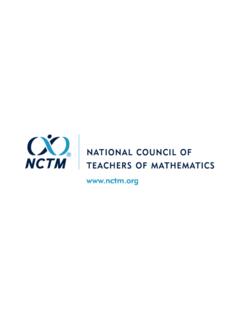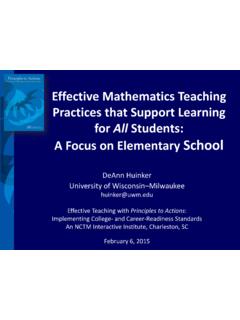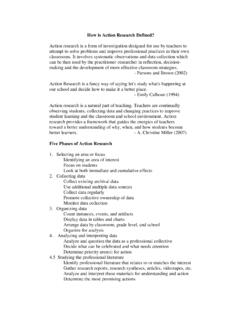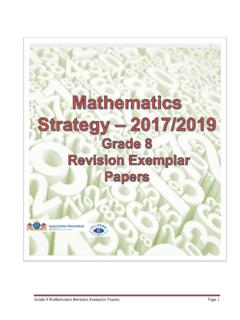Transcription of BLANK NUMBER LINES - National Council of Teachers of ...
1 BLANK NUMBER LINES . 2016 National Council of Teachers of Mathematics NUMBER LINES NAME _____. 0 1 2 3 4 5 6 7 8 9 10. 0 1 2 3 4 5 6 7 8 9 10. 0 1 2 3 4 5 6 7 8 9 10. 0 1 2 3 4 5 6 7 8 9 10. 0 1 2 3 4 5 6 7 8 9 10. 2008 National Council of Teachers of Mathematics Resources for Teaching Math NUMBER Institute NAME _____. 0 1 2 3 4 5 6 7 8 9 10 11 12 13 14 15 16 17 18 19 20. 0 1 2 3 4 5 6 7 8 9 10 11 12 13 14 15 16 17 18 19 20. 0 1 2 3 4 5 6 7 8 9 10 11 12 13 14 15 16 17 18 19 20. 2013 National Council of Teachers of Mathematics REPRODUCIBLE. Table : Domain-by-Domain Cross-Grade Analysis Grade K Grade 1 Grade 2 Grade 3. Counting and Cardinality (K only). Know NUMBER names and the count sequence. Count to tell the NUMBER of objects. Compare numbers. Operations and Algebraic Thinking Understand addition Represent and solve Represent and solve Represent and solve as putting together problems involving problems involving problems involving and adding to, and addition and subtraction.
2 Addition and subtraction. multiplication and understand subtraction division. as taking apart and taking from. Understand and apply Add and subtract within Understand properties properties of operations 20. of multiplication and the and the relationship relationship between between addition and multiplication and subtraction. division. Add and subtract within Work with equal Multiply and divide 20. groups of objects to within 100. gain foundations for multiplication. Work with addition and Solve problems involving subtraction equations. the four operations, and identify and explain patterns in arithmetic. NUMBER and Operations in Base Ten Work with numbers 11 Extend the counting to 19 to gain foundations sequence. for place value. Understand place value.
3 Understand place value. page 1 of 2. Common Core Mathematics in a PLC at WorkTM , Grades K 2 2012 Solution Tree Press Visit to download this page. REPRODUCIBLE. Grade K Grade 1 Grade 2 Grade 3. Use place-value Use place-value Use place-value understanding and understanding and understanding and properties of operations properties of operations properties of operations to add and subtract. to add and subtract. to perform multidigit arithmetic. NUMBER and Operations Fractions Develop understanding of fractions as numbers. Measurement and Data Describe and compare Measure lengths Measure and estimate Solve problems involving measurable attributes. indirectly and by iterating lengths in standard measurement and length units. units. estimation of intervals of time, liquid volumes, and masses of objects.
4 Classify objects and Tell and write time. Relate addition and Represent and interpret count the NUMBER of subtraction to length. data. objects in categories. Represent and interpret Work with time and Geometric data. money. measurement: Understand concepts of area, and relate area to multiplication and to addition. Represent and interpret Geometric data. measurement: Recognize perimeter as an attribute of plane figures, and distinguish between linear and area measures. Geometry Identify and describe Reason with shapes and Reason with shapes and Reason with shapes and shapes. their attributes. their attributes. their attributes. Analyze, compare, create, and compose shapes. General Comments Source: Adapted from NGA & CCSSO, 2010. page 2 of 2. Common Core Mathematics in a PLC at WorkTM , Grades K 2 2012 Solution Tree Press Visit to download this page.
5 What Time Is It? Board Game Materials: one NUMBER cube, one mini-clock per player, and game pieces (colored cubes or chips) one for each player NUMBER of players: Two or more players. Roll the NUMBER cube to determine who moves first. (The player with the lowest NUMBER will go first, then the next highest NUMBER and so on.). How to Play: Each player rolls the NUMBER cube to determine the NUMBER of spaces to move. Each player is to use the mini-clock to show the time described on the space he/she lands on or follow the directions on the space on which he/she lands. The first player to reach the finish line is the winner. NOTE: If the player does not show the correct answer on the clock, he/she loses his/her turn. Use your Move Cheryl met her best clock to show backward friend for lunch at the times one space 11:30 Lose one described.
6 Turn. Joshua and START his brother Marisa plays went to the with her Jasmine goes movies at friends until to bed at 8:00 2:00 on dinner time at each Saturday. 6:30 night. Recess begins at 10:30 for the students Gabriel's in Room 100. favorite subject, math FINISH. Move starts at forward two 12:30 spaces. Peter's baseball game starts at 6:00. The Watertown Waterpark opens at 10:00 Take an extra turn. 2016 National Council of Teachers of Mathematics CLOCK MATCHING GAME. 2016 National Council of Teachers of Mathematics CLOCK MATCHING GAME. 2016 National Council of Teachers of Mathematics CLOCK MATCHING GAME. 2016 National Council of Teachers of Mathematics CLOCK MATCHING GAME. 2016 National Council of Teachers of Mathematics Measurement Word Problems At the beginning of the school year, Mr.
7 Parker measured each student's height in inches. He measured each student's height again at the end of the school year. Use the table to answer the questions below. Students Height in August Height in May Ava 38 inches 50 inches Gabriel 36 inches 45 inches James 38 inches 46 inches Zaara 40 inches 46 inches Who was the tallest student in August? Who was the tallest student at the end of the school year? Put the students in order from tallest to shortest for August. Do the same for May. Look at Gabriel and Ava. How much shorter was Gabriel than Ava in May? Compare each student's height in August to his/her height in May. How much did each student grow from August to May? Which student grew the most from August to May? What is the difference in the girls' total heights in May and the boys' total heights in May?
8 Did the boys or the girls grow the most from August to May? Rafael joined the class in May. He is 9 inches taller than Zaara was in August. How tall is Rafael? 2016 National Council of Teachers of Mathematics MONEY WORD PROBLEMS. Jillian has 25 cents in her coin purse. What coins could she have? Manuel has 64 cents in his pocket. What coins could he have? Jayla has 4 nickels, 5 dimes, and 8 pennies. How much money does she have in all? Joseph has saved 1 dollar, 5 quarters, 3 dimes, 8 nickels, and 4. pennies in his piggy bank. He buys a toy car that costs $ How much money does he have left? Sierra and her sister are earned money for doing chores. Sierra has 2. quarters, 10 dimes, 5 nickels, and 25 pennies. Her sister has 2. quarters, 5 dimes, 20 nickels, and 25 pennies.
9 Who has more money? Ava is saving money to buy a new art kit for $ She has 8. quarters, 6 nickels, and 38 pennies. How much more money does she need? Bernard wants to buy a snack at Field Day. He has $ , 1 quarter, 5. dimes, 4 nickels, and 40 pennies. Which snacks can he purchase? Snack Price Hot Dog $ Ice Cream Cone .65. Soft Drink .75. Popcorn .50. 2016 National Council of Teachers of Mathematics 2016 National Council of Teachers of Mathematics 2016 National Council of Teachers of Mathematics 2016 National Council of Teachers of Mathematics Wiggly Worms Activity One Materials: 1 set of wiggly worms Measurement materials (standard and non-standard). Directions: 1. Examine the wiggly worms. Compare the lengths of the different colored worms. Which worm is the shortest?
10 Longest? 2. Order the wiggly worms from shortest to longest. 3. Measure each worm using a standard and non-standard unit of measurement. Record your findings (length of each worm in standard AND non-standard units) REMEMBER: A measurement must have a NUMBER and a unit. Example: 4 marshmallows long 4. BONUS: What is the difference in length between the shortest and longest worm? Tell how you found your answer. 2016 National Council of Teachers of Mathematics Wiggly Worms Activity Two Materials: 1 set of wiggly worms Classroom table Directions: Task 1: Measure the length of the table using the red worm. Measure the length of the table using the green worm. Record the lengths: The table is _____ red worms long. The table is _____ green worms long.











